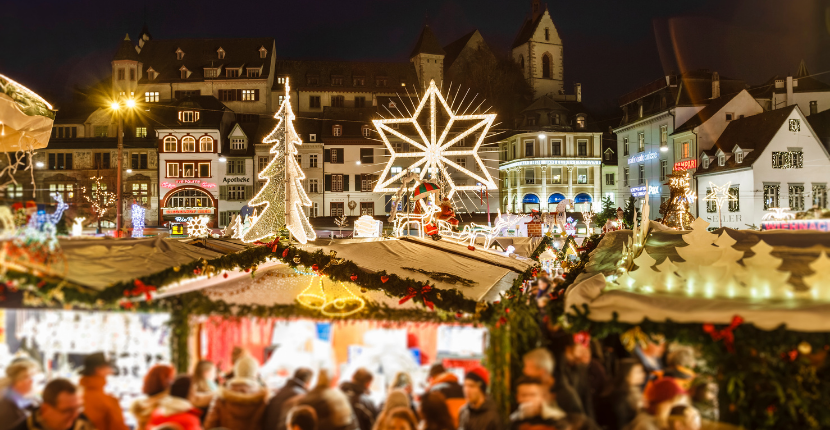A Christmas pageant at Lincoln School offers a festive learning opportunity in The Happy Hollisters and the Trading Post Mystery by Jerry West. Each class is assigned a different European country to learn more about holiday traditions that are different from those commonly observed in the U.S. In true Hollister fashion, the activity leads to plenty of fun, and even their pet donkey, Domingo, gets to play a part in a live nativity. Of course, there is also a mystery to solve, and in addition to helping the residents of Shoreham get in the Christmas spirit, the Hollister children expand their worldview by researching European Christmas traditions.
The Netherlands
Pete’s class is tasked with learning about European Christmas traditions in the Netherlands. In this country, the most important date of the Christmas season is not actually December 25th. Instead, the celebrations begin on December 6th with the arrival of Sinterklass. According to Dutch traditions, Sinterklass lives in Spain but chooses a different city in the Netherlands each year, where he arrives to lead a holiday procession on his white horse. He may climb into homes through the chimney or a window to deliver small gifts or sweets to children who have left their shoes by the fireplace.
As Pete learns in The Trading Post Mystery, Sinterklass is traditionally accompanied by a Moorish man called Zwarte Piet, or Black Peter, who assists him during his Christmastime duties. However, since the role of Zwarte Piet was typically played by a white person wearing blackface makeup, many people in the Netherlands have moved away from including Zwarte Piet in their celebrations. Some have switched to a similar character called Sooty Peter (Roetpiet), who has smudges of ash on his face from climbing through chimneys while helping Sinterklass deliver presents.
Italy
Next, learn about Christmas in Italy with Pam Hollister and her classmates! In Italy, the celebrations begin in early December and go until Epiphany on January 6th. As in the Netherlands, December 6th is an important day for Italian children. This is when St. Nicholas pays a visit to deliver nuts, fruit, or other sweet treats to children who’ve been good throughout the year. Naughty children usually also receive a sweet, but it might look like a lump of coal!
 Italy is well-known for its Christmas markets and beautiful decorations. This includes a massive tree outside St. Peter’s Basilica in Vatican City, where the pope holds a midnight mass on Christmas. A common sight around Italy at Christmastime is the presepe, or nativity scene. They are put up at churches and town squares around Italy, and many families decorate their homes with their own small presepe, though most probably don’t have their very own donkey like the Hollister family.
Italy is well-known for its Christmas markets and beautiful decorations. This includes a massive tree outside St. Peter’s Basilica in Vatican City, where the pope holds a midnight mass on Christmas. A common sight around Italy at Christmastime is the presepe, or nativity scene. They are put up at churches and town squares around Italy, and many families decorate their homes with their own small presepe, though most probably don’t have their very own donkey like the Hollister family.
Norway
Ricky is particularly lucky that his class is assigned to cover Norway for their Christmas project, because Aunt Marge, who once spent Christmas in Norway, tells them about Norwegian yule traditions, like the jul-nisse. Jul-nisse, which are also seen in other Scandinavian cultures, are tiny mythical creatures, often depicted as pixies or gnomes. As the Hollister children learn from Aunt Marge, they dress in “red knitted caps with hanging tassels, white coats, and red trousers.” They can cause Christmastime mischief, but are easily appeased by a small offering of porridge.
Caroling is a popular Christmastime activity in parts of Norway, and caroling children sometimes dress up as shepherds or wise men. A popular Christmastime song is The Mouse Song, or the Musevisa. It’s a traditional Norwegian folk song that tells the story of a family of mice who must avoid traps while getting ready for Christmas.
Switzerland
Finally, take a Christmas trip to Switzerland with Holly Hollister! In The Trading Post Mystery, Holly learns that the Swiss name for Santa is Samichlaus. He is said to reside in a nearby forest, rather than at the North Pole. He arrives in Swiss towns with a humble donkey—and a spooky companion called Schmutzli, who is said to punish naughty children. In some parts of Switzerland, Samichlaus will interview children to find out whether they’ve been good or bad, then reward them with small treats, typically chocolates, mandarin oranges, or gingerbread men.
Like in other parts of Europe, Christmastime markets are a common sight in Switzerland, as are colorful processionals to mark the arrival of Samichlaus. The processionals often feature candles, trumpets, and loud noises to scare away evil spirts who might be lurking about. The best known of these processionals, the Klausjagen, takes place in a village near Lucerne. It involves shutting off all the lights and enveloping the town in complete darkness before the celebrations begin. People wear large, illuminated hats, which are sometimes over seven feet tall, and others may balance religious-themed artwork on their heads.
From mischievous creatures to elaborate festivals, these are just a few of the many unique Christmas traditions around Europe! The Happy Hollisters and the Trading Post Mystery is a great starting point for educational family discussions of Christmas traditions in other parts of the world, so pick up a copy of this Christmas mystery from The Trading Post Store and explore European Christmas traditions with the Happy Hollisters!
by Libby Svenson Kennedy
Sources:
Research notes, Andrew Svenson Archives of The Hollister Family Properties Trust
https://www.whychristmas.com/cultures/holland.shtml
https://www.whychristmas.com/cultures/norway.shtml
https://www.alpenwild.com/staticpage/swiss-christmas-traditions/


How fun to learn about these celebrations! My son learned about boot night from a friend in Kindergarten, so it became a tradition in our home as well.